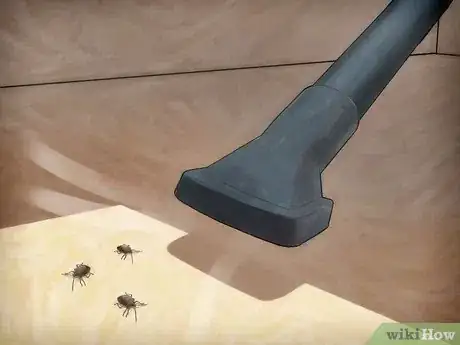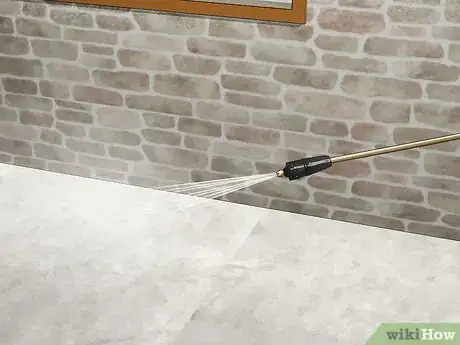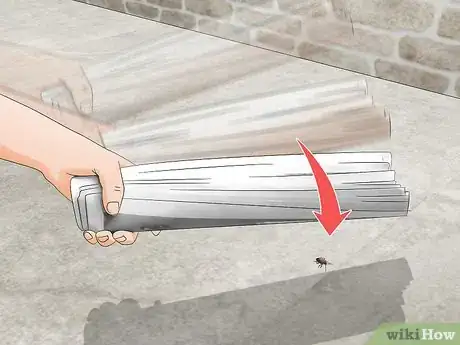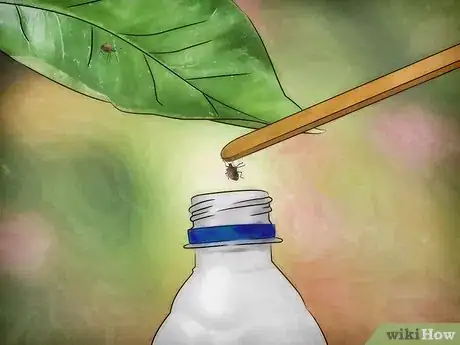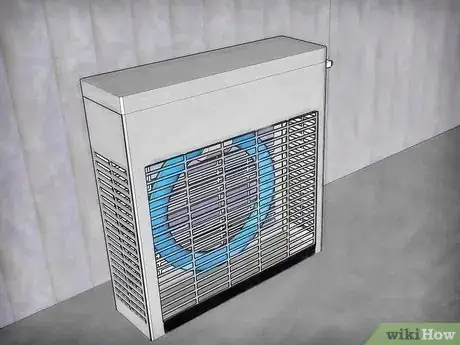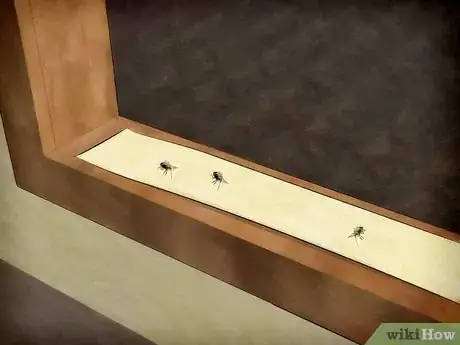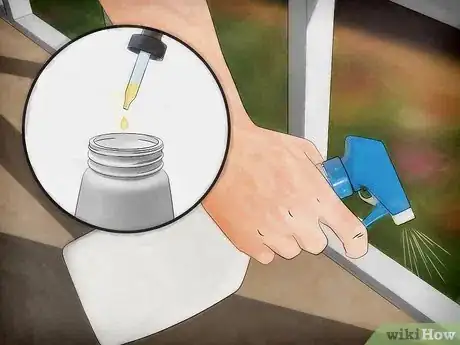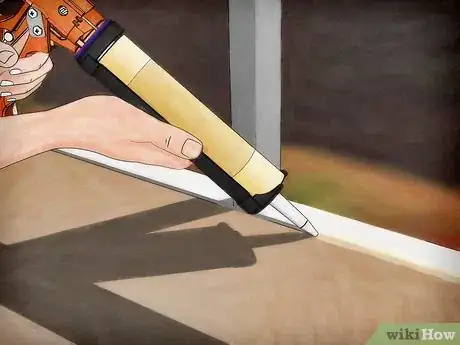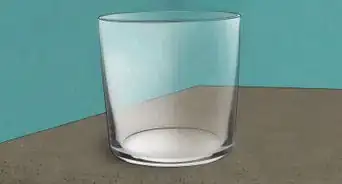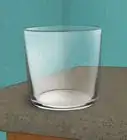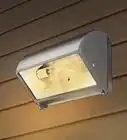This article was co-authored by Scott McCombe. Scott McCombe is the CEO of Summit Environmental Solutions (SES), a family-owned local pest solutions, animal control, and home insulation company based in Northern Virginia. Founded in 1991, SES has an A+ rating with the Better Business Bureau and has been awarded “Top Rated Professional,” and “Elite Service Award" by HomeAdvisor.
wikiHow marks an article as reader-approved once it receives enough positive feedback. This article received 39 testimonials and 100% of readers who voted found it helpful, earning it our reader-approved status.
This article has been viewed 1,759,440 times.
Stink bugs are pesky 6-legged critters with straight antennae and shield-like bodies. Although they usually keep their wings folded up, they can be found fluttering around in warm weather. While they won’t cause structural damage to your home, they can destroy gardens, orchards, and farms. Luckily, there are plenty of natural methods you can use to catch and destroy stink bugs. Try luring them with water or natural pesticides, but be careful not to crush a stink bug as it will release a terrible stench. As a preventative method, take care to bug-proof your home by sealing up small holes and eliminating weeds so they don’t have any hiding spots or entry points.
Things You Should Know
- Knock stink bunks into a bucket of soapy water to quickly kill them.
- Fill a shallow dish with soapy water and place it under a downward-facing lamp to make a stink bug trap.
- Spray plants with neem oil to kill stink bugs and prevent them from laying new eggs.
- Seal gaps around your doors, windows, and walls to prevent stink bugs from getting inside.
Steps
Removing Stink Bugs
-
1Look around to find where the stink bugs are located. If you see just 1 stink bug, it may indicate a larger issue. Look around for warm pockets near heating vents or sunny spots along your walls and windows. Keep your eyes peeled for their brown, gray, or green bodies that may blend into the surrounding area.[1] If you have an outdoor infestation, look on the underside of leaves for eggs and keep an eye out for discolored leaves.
- Stink bugs prefer tomatoes, peaches, apples, grapes, berries, corn, soybeans, peppers, alfalfa, and wheat, so check these plants first.
- If you haven’t crushed any stink bugs but start to notice a cilantro-like odor in your home, chances are you have an infestation.
-
2Vacuum up a stink bug to kill and remove it. Suck the stink bugs up using a vacuum cleaner with a bag.[2] For stink bugs sitting on walls or in crevices, use a small vacuum attachment to capture them. Discard the bag immediately to keep the smell out of your home.
- Alternatively, you can wrap a stocking around the vacuum attachment tube to catch the bugs before they reach the bag or filter. Secure the stocking with a rubber band and push it inside the tube. Once you’ve sucked up the bugs, pull out the stocking, tie off the end, and dispose of it immediately.
- Refrain from using a bagless vacuum as it may smell foul for several weeks. Make sure you use a vacuum cleaner with a disposable bag.
Advertisement -
3Knock stink bugs off plants by spraying them with a garden hose. Once you spot stink bugs on your plants, use a high-pressure jet setting on a garden hose attachment to detach them from the leaves. Once you’ve forced them away, keep monitoring the plants in your garden to see if the stink bugs reappear.[3]
- The water pressure won’t necessarily kill them off, but this is a good tactic to use to protect your plants at a moment’s notice.
-
4Flick the stink bugs into a bucket of soapy water to catch and kill them. Instead of spraying a solution onto the bugs, mix up a solution of 4 cups (950 mL) of hot water with 3⁄4 cup (180 mL) of mild dish soap in a bucket. Hold this beneath the climbing stink bugs and flick them down into the solution using a gloved hand. After a few hours, drain out the water, bag up the dead bugs, and dispose of them immediately.
- The soap will make it difficult for the insects to move, and they will ultimately drown in the water.
- As far as stink bug elimination methods go, this is probably the closest to an odorless option since the bugs will be killed relatively quickly.
-
5Crush a stink bug with a disposable item if you find it outside. If you spot a single stink bug scuttling around your property, use a rolled-up magazine or another firm but disposable object to squash it. Scoop up the remains with a piece of paper towel and then bag up and dispose of the crushing tool and debris. The nasty smell may keep other stink bugs away.
Setting Traps
-
1Use a desk lamp to draw stink bugs to a tray of soapy water. Fill up a shallow pan or tray with soapy water. Mix up about 4 cups (950 mL) of hot water and 3⁄4 cup (180 mL) of mild dish soap, or less for a smaller container. Place the tray near where you’ve spotted the stink bugs. Then insert a white, blue, or blacklight bulb into a downward-facing desk lamp and shine it over your trap to attract the stink bugs.
- Wait at least 12 hours and you’ll start to see the stink bugs congregating and dying in the soapy water.[6]
- The stink bugs will be attracted by these types of lights. A standard incandescent bulb may not work as well.
-
2Lay out a wet towel outside for the stink bugs to gather on. Saturate a towel with water and wring it out so that it’s damp, rather than dripping. Bring it outdoors and drape the towel over a deck railing, an empty planter, a tree branch, or any other surface in your yard. It’s most effective when draped vertically. Leave it there overnight. The next day, you’ll see stink bugs sitting on the towel drinking the water. Submerge the bug-laden towel in a bucket of soapy water to kill the bugs.[7]
- After a few hours, carefully pull out the towel and be sure to knock all of the bugs back into the water. Drain the bucket and catch the bugs in a plastic bag to dispose of them.
- Make sure to thoroughly wash the towel after trapping the bugs if you plan to use it for anything else.
-
3Trap an individual stink bug in an empty container. Flick a bug into the container while it’s face-up, or pop an empty, unlidded container face-down over a bug to trap it. Then slip a piece of paper underneath the opening to create a temporary lid so you can flip the container over and keep the bug inside. Then screw on the lid tightly. Once you’ve caught it, either bag it up and dispose of it in an outdoor garbage can or flush it down the toilet.[8]
- Add some soapy water to the container to more quickly kill the bugs.
- If you’re trying to catch a flying stink bug, know that they have relatively slow reflexes. Keep your eye on the bug and try to capture it after it lands.
-
4Use an electric insect trap to zap stink bugs. Purchase an electric insect trap from a hardware store and install it near where the stink bugs gather, according to the manufacturer's instructions. Turn it on at night to attract the bugs. As they approach the trap’s bright light, they’ll get a sudden shock of electricity.
- The next morning, turn off the trap and shake off or vacuum away any dead bugs.
-
5Spread fly tape along stink bug entryways to capture them. Apply sticky fly tape along windowsills, doorways, cracks, vents, and any other notable entryways around your home. Check the tape every day for trapped bugs. To keep the odors at a minimum, bag up and discard the whole strip once you catch a single stink bug, then replace the strip.
- Keep in mind that since this is not a quick death, trapped stink bugs may give off their trademark odor after being caught.
- Fly tape can be purchased at a hardware store.
- If you prefer, make a natural sticking trap by boiling a solution of equal parts water, sugar, and corn syrup. Once it’s boiled and cooled, spread it onto a piece of cardboard.
Using Natural Pesticides
-
1Spray the stink bugs you see with a soap, water, and lavender oil solution. Mix 4 cups (950 mL) of hot water with 3⁄4 cup (180 mL) of mild dish soap. Use a spray bottle to spritz this solution directly onto stink bugs or on the vegetation they’ve been gathering on.[9] Or try a mixture of equal parts hot water, mild dish soap, and lavender oil to kill the bugs and keep them away.
- Soap kills stink bugs by breaking down their protective exoskeleton and dehydrating them.
-
2Use a neem oil spray to prevent stink bugs from laying new eggs. Combine 4 cups (950 mL) of warm water with 2 tsp (9.9 mL) of neem oil in a spray bottle. Shake it thoroughly, then spray it generously on leaves, windowsills, and other potential entryways or hiding spots around the perimeter of your home.[10]
- As a preventative method, repeat this every other day for about a week.
- Neem oil works by disrupting the eating and mating instinct of insects. As a result, adult stink bugs that are exposed to it will gradually starve themselves and will not lay any eggs.
-
3Sprinkle diatomaceous earth (DE) around your property to kill bugs when they try to enter.[11] DE is a natural sedimentary rock containing silica, alumina, and iron oxide that is often used as a natural pesticide. Spread this chalky powder both outside and inside, focusing on entryways like windows and doors along with other areas where stink bugs seem to gather. Dust any stink bugs you see with the powder directly, in addition to spreading the powder out in areas where stink bugs gather.
- DE works by breaking down the waxy protective layer on an insect's exoskeleton, essentially causing the insect to dehydrate.
- Look for a bag of DE at your local hardware store.
Taking a Preventive Approach
-
1Seal up any gaps around your walls, windows, and doors. Inspect the corners of window frames, doorways, and baseboards for gaps.[12] Look for damaged linings and weather stripping, too. Use caulk or expandable foam to seal off any holes you find.
- Stink bugs will sneak into any little crack or crevice they can find, so take action to seal off as many holes as you can.
- If you have a fireplace, attic, or other rarely-used entryways, check these areas, too. Keep doors and fireplaces flues closed while they’re not being used.
-
2Install or repair protective screens over air vents and windows. Patch and repair any holes in your window or door screens. Use mesh screening to cover dryer vents, air vents, chimneys, and other open areas connecting the outside of your home with the inside.
- Use foam strips around your window air conditioning units to create a tight seal.
-
3Keep your land free of weeds. Stink bugs like to hide in dry soil beneath the cover of weeds.[13] Whether you have a small patch of grass or a large property, take good care of it. Pull out all of the weeds from your property and invest in natural lawn care services to keep your grass healthy and free of weeds. Keep the soil and plants on your property healthy, nutrient-rich, and well-pruned.
- Consider cultivating beds around your property if you’d like to grow flowers or vegetables. By spending time outside taking care of your vegetation, you’ll be able to catch weeds and stink bugs sooner.
- Avoid simply mowing over weeds; this will only encourage stink bugs to find another home nearby.
Expert Q&A
Did you know you can get expert answers for this article?
Unlock expert answers by supporting wikiHow
-
QuestionHow do I prevent stink bugs from getting in my house?
 Scott McCombeScott McCombe is the CEO of Summit Environmental Solutions (SES), a family-owned local pest solutions, animal control, and home insulation company based in Northern Virginia. Founded in 1991, SES has an A+ rating with the Better Business Bureau and has been awarded “Top Rated Professional,” and “Elite Service Award" by HomeAdvisor.
Scott McCombeScott McCombe is the CEO of Summit Environmental Solutions (SES), a family-owned local pest solutions, animal control, and home insulation company based in Northern Virginia. Founded in 1991, SES has an A+ rating with the Better Business Bureau and has been awarded “Top Rated Professional,” and “Elite Service Award" by HomeAdvisor.
Pest Control Specialist
Warnings
- Whatever you do, don’t squash a stink bug indoors. It will give off a foul odor that can linger for a while.⧼thumbs_response⧽
Things You'll Need
Removing Stink Bugs
- Vacuum cleaner
- Hot water
- Mild dish soap
- Garden hose
- Bucket
- Gloves
- Magazine
Setting Traps
- Shallow pan or tray
- Hot water
- Mild dish soap
- Desk lamp with a white, blue, or blacklight bulb
- Towel
- Electric insect trap
- Fly tape
Using Natural Pesticides
- Mild dish soap
- Hot water
- Lavender oil
- Neem oil
- Diatomaceous earth
Taking a Preventive Approach
- Caulk
- Mesh screens or screen patches
- Gardening tools
References
- ↑ https://www.pests.org/get-rid-of-stink-bugs/
- ↑ Scott McCombe. Pest Control Specialist. Expert Interview. 19 November 2019.
- ↑ https://www.pests.org/get-rid-of-stink-bugs/
- ↑ Scott McCombe. Pest Control Specialist. Expert Interview. 19 November 2019.
- ↑ https://www.pests.org/get-rid-of-stink-bugs/
- ↑ https://www.pests.org/get-rid-of-stink-bugs/
- ↑ https://www.pests.org/get-rid-of-stink-bugs/
- ↑ https://www.pests.org/get-rid-of-stink-bugs/
- ↑ http://www.mnn.com/your-home/at-home/stories/how-to-get-rid-of-stink-bugs
- ↑ https://www.pests.org/get-rid-of-stink-bugs/
- ↑ Scott McCombe. Pest Control Specialist. Expert Interview. 19 November 2019.
- ↑ Scott McCombe. Pest Control Specialist. Expert Interview. 19 November 2019.
- ↑ https://www.pests.org/get-rid-of-stink-bugs/
About This Article
To get rid of stink bugs, make a natural pesticide by combining 2 cups of water with 4 teaspoons of garlic powder. Then, put the mixture in a spray bottle and cover plant leaves and window sills with the spray. Alternatively, combine 2 cups of water with 10 drops of mint oil to make an equally effective spray. To physically remove stink bugs, vacuum them up but be sure to dispose of the bag immediately afterwards. You can also brush the bugs into a bucket of soapy water with a gloved hand, since soap kills stink bugs. For tips on how to keep stink bugs out of your home, read on!

